THE GIST: Tucson in a tiny nutshell
With sunglasses, sunscreen lotion, and a car, it's a very easy place to live.
Car-dependent, but bikable if you live in Central Tucson.
There is a bus system that's not widely used, but by 2026(?) there will be an electric streetcar.
Great
year-round hiking. If you come from a small town, it'll feel big.
If you come from a big city (e.g. New York or more specifically Manhattan, Brooklyn,
or Queens;
Boston
or
San
Francisco), it will feel small, suburban, and very sprawly.
There are no seasons and there is no ocean or much water at all (it's the desert!). The
U
of
A
campus
is
pretty,
well
laid
out,
walkable and, home
to some 35k students. [View the "near UA campus" Map]
Tucson in a nutshell
- Warm dry climate year-round (70's during summer nights and
winter days), with temperature drops of 30 degrees at
night.
- Summer days too hot (over 100 F), but if you are a
student, you don't have to be here.
- Excellent hiking, cycling, and mountain biking, with
conducive climate year-round.
- Pretty historic districts with quaint Spanish Colonial
(or is it
Spanish Colonial Revival?) architecture,
and some other cool styles I can't identify.
- Tucson has two institutions of higher learning: the University
of Arizona and Pima Community College. The University of
Arizona (aka "the U of A") has a
very pretty campus. Undergraduates live on and off campus,
graduate students live off campus. Students can afford to live
within walking and biking distance of campus.
- Although I am not into sports, I have come to think that
it's a good thing that people are into Wildcats basketball
and even football; makes for lots of school spirit.
- On October 2006, Jet Blue started flying direct to Tucson
from New York (first direct flight here from New York and
not from Newark, NJ, from where I think Continental flies
nonstop, at least in the winter).
Also, United
Airlines
flies nonstop to Tucson from
Washington DC. (There are lots of direct flights to Phoenix
from lots of places; Tucson is starting to catch up.)
Amtrak
goes here too...
- Even though Tucson is a very car-dependent city, there
is only one highway going through the city (I-10). Although
having only one highway is bad for car traffic, at least in
the shortrun, in the longrun it is probably
a good thing because highways would obstruct mountain
views in some parts of town, they would look ugly themselves,
and they would divide up the city. I think it also makes
the city ready for street-level electric streetcars/trolleys
like they have in Portland, Oregon. Oh
wait, a project like already got approved in May of
2006.
- Although there is
currently a downtown revitalization project underway, as of
now, the area around the U of A campus
is really
the center of town and student life. This
includes Fourth Avenue (six blocks of shops and restaurants),
Main Gate Square (two
blocks on University Blvd right in front of campus's main
gates), Club Congress in Historic Hotel Congress
(downtown next to Fourth Avenue),
and the U of A campus itself.
- Overall I think Tucson is improving: there is new
mixed-use residential and commercial construction downtown,
old houses are becoming restored and renovated (e.g. just
South of University in Rincon Heights), neighborhoods are
interested in overall improvement,
and there are now
new nonstop flights from New York and Washington D.C..
There is a bus system, but it's not widely used.
However... (read the next bullet -->)
- public
transportation should improve in the next
twenty years as the Regional Transportation Authority (RTA)
Plan got approved by the voters in May of 2006. The plan
(or part of the plan?) is federally sponsored and includes
building an electric streetcar connecting the U of A, downtown,
4th Avenue, and the Arizona Health Sciences Center. This
$2.1 billion RTA plan will be implemented through 2026.
Independent from this, there is also some talk at the state
level of possibly connecting Phoenix and Tucson by train.
(Phoenix has already started building a lightrail for just
Phoenix.) For more information see www.RTAmobility.com and also www.tucsontransitstudy.com. [See next bullet...]
-
Public transportation and a bit of historical
context: Ironically, Tucson's building of an electric streetcar is in a
sense a rebuilding of what Tucson had over a century ago! Tucson had
mule-driven streetcars as early as the end of the 19th century, which were
replaced by an
electric streetcar in 1906 (!) which connected campus and downtown.
(Yes, in 1906, three years before Arizona was even a state.) But in
the 1930's, as happened in many other American cities, progress demanded
that the electric streetcar be replaced by stinky gasoline-powered buses.
Now, a century after Tucson already had an electric streetcar, voters
finally approve a plan to resurrect this simple public transportation
concept. If you look on the South side of University Blvd, yards
away from the Main Gates to the U of A campus, you will find an epitaph to
the electric streetcar line of 1906 installed there by the Tucson Historic
Society.
Tucson in a bigger nutshell
The climate
It's the desert, so temperature swings about 20 to 30
degrees Fahrenheit between night and day. Warm winters (80
in the daytime in November), hot summers (70's
at night, 100+ in the daytime), some humidity only two
months a year during the Monsoon Season (July and August)
when sunsets are all shades of red and pink (very pretty)
and the desert is in bloom. It rains only
during monsoon and in the winter (but when it rains it
pours; no drizzle here). Mostly, it's bright and sunny with
blue cloudless skies.
Because there is no humidity (and no clouds), daylight is typically
unusually bright; you will probably be hurting without sunglasses.
The geography
Desert surrounded by mountains. Tucson is in the valley
surrounded by mountains on three sides. From campus, the
view of the mountains to the north is probably the most
impressive.
Outdoor recreation
Hiking, moutain biking, street cycling. Not sure how close
mountain climbing is... There is camping close to Tucson
too.
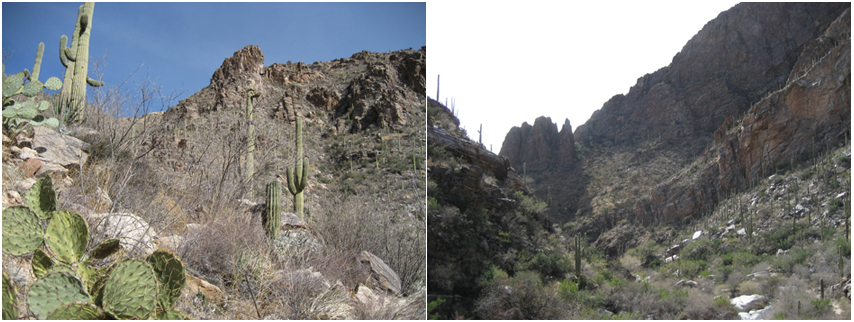
Hiking Ventana Canyon in a t-shirt in late January (Tucson; Jan 28, 2007)
Culture
I am not qualified to talk about Native American culture, or
even the punk/rock music scene, so I'll just skip to things
I know about.
Tucson has an
orchestra,
an opera house, and world-class visitors (which in the
past have included Momix, Yo-Yo Ma, Barrueco, and Moscow
Philharmonic Orchestra, among others),
which mostly preform on campus. Tucson
also has a cool
chamber music society that also has regular visiting performers
and has also in the past commissioned original works.
Tucson lacks a jazz scene. One Friday night I had some tapas
at a restaurant downtown called "Casa Vicente" and
got to hear good flamenco guitar playing. Beyond that,
however, I don't know anything about the local Spanish
guitar / flamenco scene (although you'd think there must be
something going on in a former Spanish settlement).
U of A campus
The campus is great. It is well layed out and pleasing in
terms of architecture and landscaping, and it is well
maintained. It also has more wheelchair access than I've
seen elsewhere.
Together with University Blvd and 4th
Avenue, it comprises the walkable part of Tucson, filled
with pedestrians and bikers, as well as restaurants and
stores next to each other. For more on campus, including a
few pics, scroll down.
The city... from a New Yorker's point of view
At present, Tucson is a car-dependent city with a somewhat dead
downtown center surrounded by suburban housing.
There is currently a strong effort underway to revitalize
downtown, which got scarred by urban renewal in the late
60's. This effort includes attracting businesses and
residents downtown. Some new stores and restaurants have opened
up dowtown and new residential lofts and houses were getting
built there before 2008.
As of now, however, the center of town is still
Fourth Avenue
(which is not downtown),
although I really hope downtown will catch up.
Tucson is not pedestrian friendly as it lacks sidewalks, street
lights, and is dependent on shopping chains (e.g. Safeway, Fry's,
Trader Joe's, Target, three or so shopping malls) that are
not within walking distance of most residences.
The area around campus,
however, makes for a notable exception. Namely, the U of A
campus, the little residential
neighborhood directly west of campus (between campus and Fourth
avenue), and Fourth Avenue
(full of restaurants and bars) and the two blocks of University
Blvd leading from campus's main gates are all
pedestrian-friendly,
with sidewalks and pedestrian street lights.
Downtown, I
take it, used to be pedestrian and vibrant, albeit rundown,
full of local shops, markets and barbershops, as well as
three plazas,
before the urban renewal project (approved by mayor and city
council in February of 1965 and started in 1967) demolished 319 houses in or near the Barrio and
Presidio neighborhoods
to make way for the Tucson Convention Center with its enormous
parking lots occupying an area of
over 35 acres. (Maybe Tucsonans should do with it what Freiburgeans did with a former French military base.)
Despite this, a number of quaint historic neighborhoods around town have survived (Iron
Horse District, El Presidio, Armory
Park, Sam Hughes, and more than a dozen other national historic
districts).
Many houses in these
neighborhoods have been restored (hence the higher home
prices).
There is also currently a strong
effort underway to revitilize the downtown area with the Rio Nuevo project to make it a more desirable
place to live and shop.
And in May of 2006, the voters approved
the electric streetcar project.
The city (or its
neighborhoods?) has also invested in building pedestrian
walkways along the dried-up riverbed (e.g. near River Rd and
Campbell Ave). These mostly do not get used for
on-foot transportation (e.g. to go to the grocery store),
but rather serve the function of a public park (e.g. to
provide local residents with walkways to stroll and where to
walk
their dogs in the cool evenings).
As far as shopping chains
go, it's not all chains of course. There are a few
non-chain grocery stores sprinkled around town: the few I
know of are 17th Street
Market (a real market downtown where local farmers and
producers come),
Caravan (a middle-eastern
grocer with good olives at 2817 N Country Club), European Market & Deli
(the only Russian/Ukrainian grocer; 4500 E Speedway Blvd, #36),
Rincon Market (small grocer for Sam Hughes
residents), and Time Market (an even smaller grocer for those
who live in West University). There are also many local
restaurants, from cheap Mexican
joints to fine dining like Janos [pronounced "YAnos") who
works with local farmers and makes it a point to make
French-quality (but not
French) food with local ingredients that has a
Tucson-inspired flavor.
(See more below on places to eat.)
Student housing
Many undergraduates live on campus, especially in their
first year. Almost all graduate students live off campus.
Housing near campus is
affordable on a student budget, which together with warm
weather year-round make a bike commute to campus easy and
enjoyable. (Also, there are four bike paths leading from
campus in four different directions.) Directly east of
campus is the expensive neighborhood of Sam Hughes, which is probably way too
expensive for a student budget. The area west of campus
(West University) has been
restored and is now expensive, but can still be affordable to
students. The area north of campus (North University) I am
not sure about. Most students live in Rincon Heights, the
area directly south of campus. This area is a bit rundown
(as its nickname, the student ghetto, suggests), but is very
affordable for how close it is to campus. There are also
signs of interest in and actual improvement in Rincon
Heights, so my guess is that in the coming years, more
houses will get restored (especially as house ownership
changes hands) and that the area will gain sidewalks
and streetlighting, and maybe even a small park on the
grounds of a vacant city-owned lot. If this happens,
however, expect rent prices to rise.
A few food-related places I like in Tucson
[See my "Tucson around the UA" map]
Coffee shops near campus: (no car needed)
Canyon Cafe
-- on campus, but has too few places to sit to qualify as a coffee shop
Espresso Art -- next
to campus, free wireless internet
Starbuck's -- next to campus
Epic -- hippy and within walking
distance from campus, free wireless
Bentley's -- biking distance from
campus, free wireless and good food
Coffee shops I'd drive to... if I had a car:
Ike's -- free wireless and good food
Raging Sage has great ambience and the
best coffee in town (but no food or wireless)
(Coffee Xchange and Caffe Diva don't do it for me)
Also, see here
I've never been but would like to check out
Froth Coffee Bar,
6th Street Cafe (biking distance from campus) and
The Coffee Vein.
Random places to eat:
Fine dining:
Chef Janos has his own
philosophy of eating out and has been
invited to give talks in Prof. Keith Lehrer's seminars on
aesthetics. But if you are a
student, you probably won't be able to afford to eat at his
two restaurants, Janos Restaurant and J-Bar, which are
adjacent to each other and share a kitchen, but have
different menus and prices). There are others too, but a
graduate student would be the wrong person to ask.
A little more affordable:
The B-Line is close campus is my
favorite place to get dinner on Fourth Avenue.
Lerua's at 2005 E Broadway Blvd is my personal favorite for
Mexican food. (I really like their vegetarian tamales.)
Miss Saigon is the only good
Vietnamese place I found in town (and it's right next to
campus).
Ghini's is a good place to go for breakfast or lunch with a romantic date, or without. 1803 E Prince Rd.
Desert:
Frost's gelato is well worth the trip.
Santa Barbara Ice Creamery, a chain store on Campbell, makes
mean milk shakes.
Beyond Bread is a local chain and is another place to
go for lunch; they also bake bread.
Bakeries:
Beyond bread -- a bread brakery and good sandwich place
Paradise Bakery -- a bread bakery at 7109 N Oracle Rd
Great Harvest -- a bread bakery at 7090 N Oracle Rd
#136
Ghini's bakes sweets.
Nadines Bakery, at 4553 E Broadway Blvd, has really good
Russian tea biscuits (but not very good cakes).
The 17th Street Market downtown is worth checking out.
This has nothing to do
with food, but I keep on meaning to check out
Gerson's Used Building Materials at 1811 S Park Ave.
Cheap or artsy movie theaters
The Loft
U of A Gallagher Theater
Grand Cinemas
The UA campus
You can see a birdseye realtime view of campus at http://www.cs.arizona.edu/camera/.
The U of A campus is pretty. My alma mater's state campus is pretty
ugly, so I was very pleasantly surprised. It's well maintained and
architecturally pleasing. Here are some pics I took around campus.
It's a compact campus with forty thousand student (is that right?), so it's
usually pretty lively, at least when school is in session.
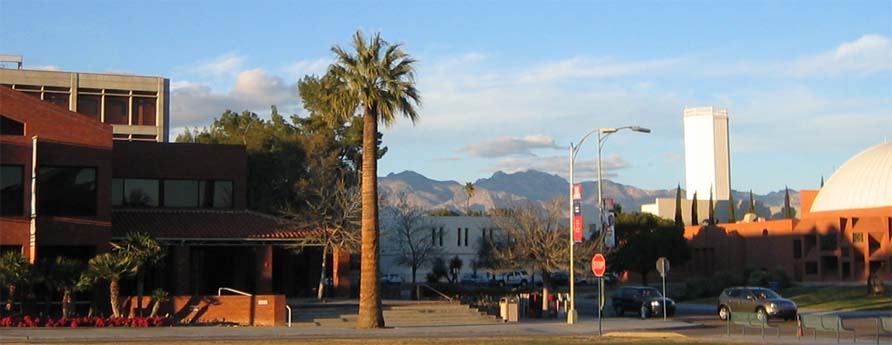 [Campus,
February 2005] Your back is to the library and you are facing North.
The mountains you see are the biggest ones near Tucson and are called
Santa Catalinas (Mt. Lemmon is a popular destination there). The
buildings on the left and right are space science related I think.
You can get a better view of the mountains from the fourth or fifth
floor of the library. This is where the mall starts and stretches
to the left to Old Main. (The mall runs East-West). [Campus,
February 2005] Your back is to the library and you are facing North.
The mountains you see are the biggest ones near Tucson and are called
Santa Catalinas (Mt. Lemmon is a popular destination there). The
buildings on the left and right are space science related I think.
You can get a better view of the mountains from the fourth or fifth
floor of the library. This is where the mall starts and stretches
to the left to Old Main. (The mall runs East-West).
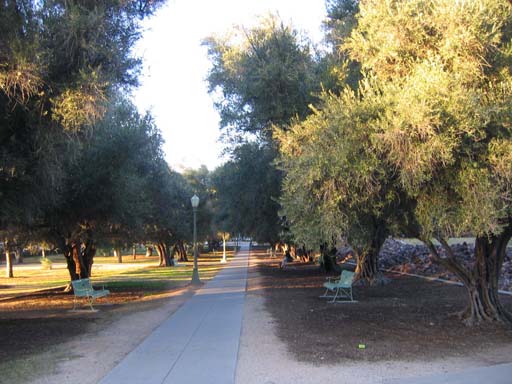
[Campus, February 2005] "The Arboretum" (None of these
trees are actually indigenous to campus, or to Tucson, at least definitely
not at this altitude.)
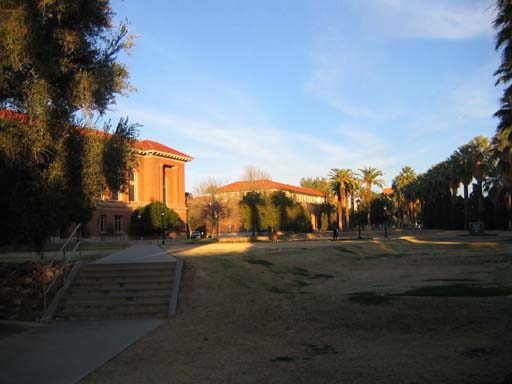
[Campus, February 2005] Slightly to the right of the Arboretum (see pic above). The sun is starting
to set as you can see from the shadows.
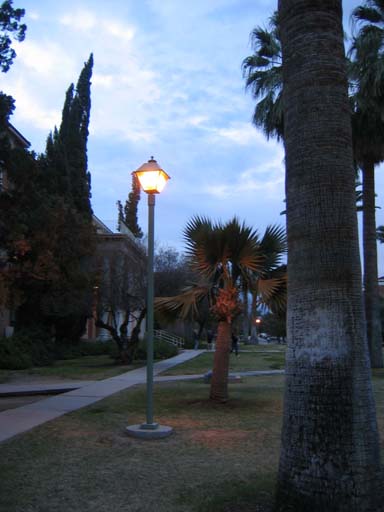
[Campus, February 2005]
On the way from the music
building to SBS, cutting through campus at dusk.
August 2004 (my first two weeks here)
Coming from the North-East, I was expecting to see scorpions
running amok and spiders jumping out of library books. And
I was expecting it to be so hot that spit would evaporate before
it hit
the
ground.
I suspect that to see venemous bugs and snakes, I will have to really
go
out of my way, maybe start hiking. And I think I've enjoyed the second
half of August here a lot more than New York's summer
mugginess. Sure, when it hit 100 degrees Fahrenheit I
thought it was pretty hot, but that's only if you're stuck
walking around for more
than ten minutes in direct sunlight. And I get by without
air conditioning. I do have a swamp cooler (people back East
never heard of a swamp cooler?), but even that I often turn
off at night.
The rain in August is nice and sunsets are really pretty with pink
clouds and I can see the mountains from my stoop. At nights the weather
is perfect. In the day time it can be a bit hot (especially when
it hits 100), but only if you're in direct sunlight. And indoors
it's always air-conditioned. One thing you absolutely need down here
is sunglasses. There is no water in the air to deflect
and disperse the light, so it's really bright out.
September 2004 (a few hours from Tucson)
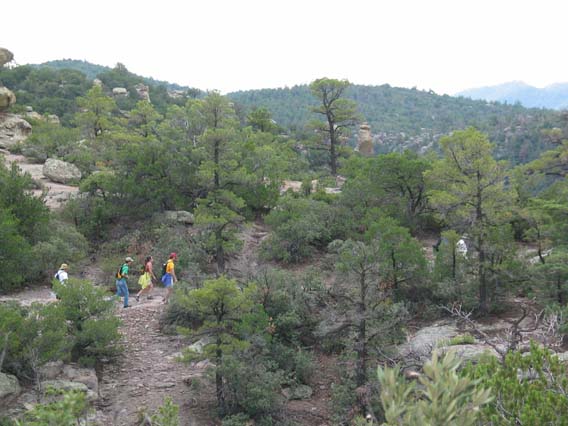
[Chiricahuas Hike, September 18, 2004. Taken by Sarah Wright?]
Starting off...
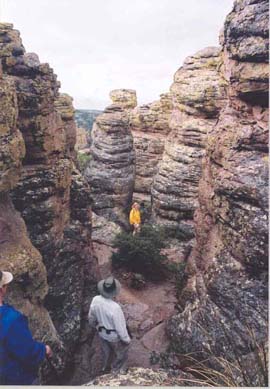 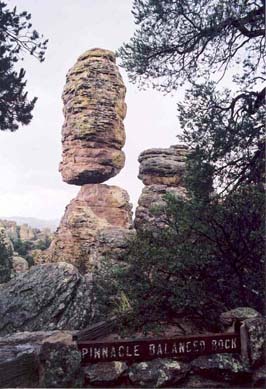
[Chiricahuas Hike, September 18, 2004. Taken by Sarah Wright?]
Left: Dave and Richard in the
heart of rock.
Right: Pinnacle Balanced Rock
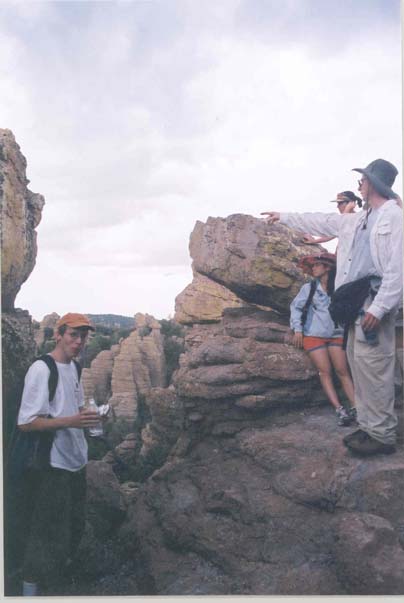
[Chiricahuas Hike, September 18, 2004. Taken by Sarah Wright?]
Looking for that lunch spot...
|

 [Campus,
February 2005] Your back is to the library and you are facing North.
The mountains you see are the biggest ones near Tucson and are called
Santa Catalinas (Mt. Lemmon is a popular destination there). The
buildings on the left and right are space science related I think.
You can get a better view of the mountains from the fourth or fifth
floor of the library. This is where the mall starts and stretches
to the left to Old Main. (The mall runs East-West).
[Campus,
February 2005] Your back is to the library and you are facing North.
The mountains you see are the biggest ones near Tucson and are called
Santa Catalinas (Mt. Lemmon is a popular destination there). The
buildings on the left and right are space science related I think.
You can get a better view of the mountains from the fourth or fifth
floor of the library. This is where the mall starts and stretches
to the left to Old Main. (The mall runs East-West).





